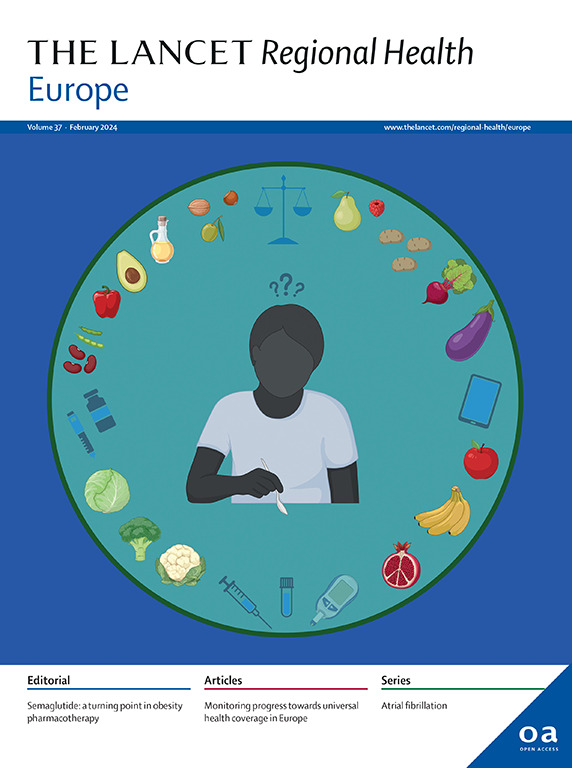在COVID-19大流行之前、期间和之后(2008-2024年),英格兰医院记录的肺栓塞的时间趋势:一项基于人群的观察性研究
IF 13
Q1 HEALTH CARE SCIENCES & SERVICES
引用次数: 0
摘要
covid -19感染增加了肺栓塞(PE)的风险。需要最新的PE住院率报告,以便为服务规划提供信息,并根据大流行制定基准。我们的主要目标是量化2008年至2024年英格兰首次医院记录PE的月度趋势,特别关注大流行时期。第二个目的是研究这些趋势如何随年龄、性别、社会经济剥夺和地区而变化,通过交互式在线仪表板提供持续的公众访问。方法:利用2008年4月至2024年12月英国国家二级医疗数据,对所有首次确诊的PE患者进行流行病学人群研究。比较了2019冠状病毒病大流行(2020年3月)爆发前后的趋势,并按年龄、性别、地区和贫困状况进行了分析。研究发现,共有750109名体育新生入学。年龄标准化首次住院记录的PE率从2008年4月的每10万人5.4例上升到2020年1月的8.5例,在大流行期间飙升至2021年1月的16.8例。这一激增在很大程度上是由新冠肺炎共存的pe造成的。此后,发病率有所下降,到2023年初恢复到大流行前的水平(例如2023年3月,每10万人中有8.6人),并可能继续下降,具体情况有待进一步更新。区域和贫困梯度贯穿始终,但在大流行期间更为明显。虽然在2019冠状病毒病大流行期间,医院记录的PE发病率飙升,但此后该比率已恢复到大流行前的水平。虽然现在确定最近的下降趋势是否可能开始扭转大流行前十年观察到的一些上升趋势还为时过早,但通过我们的在线工具对医院记录的PE进行持续监测将使这些发现保持最新状态。随着临床实践和PE管理途径政策的发展,医疗机构对PE发病率的持续监测很重要,因为它有助于支持护理计划;它还为数据支持的临床试验提供信息,其中PE是一个结果,以及观察性研究的设计。本研究得到了英国国立卫生研究院牛津生物医学研究中心和英国健康数据研究所的支持。本文章由计算机程序翻译,如有差异,请以英文原文为准。
Temporal trends in hospital-recorded pulmonary embolism in England before, during and after the COVID-19 pandemic (2008–2024): a population-based observational study
Background
COVID-19 infection increases the risk of pulmonary embolism (PE). Up-to-date reporting of hospitalisation rates for PE is needed to inform service planning and for benchmarking in light of the pandemic. Our primary aim was to quantify monthly trends in first-time, hospital-recorded PE across England from 2008 to 2024, with particular focus on the pandemic period. A secondary aim was to examine how these trends varied by age, sex, socioeconomic deprivation, and region, providing ongoing public access through an interactive online dashboard.
Methods
We conducted an epidemiological population-based study of all first-time PE diagnoses using English national secondary care data from April 2008 to December 2024. Trends before and after the onset of the COVID-19 pandemic (March 2020) were compared, with analyses by age, sex, region, and deprivation.
Findings
A total of 750,109 first-time PE admissions were identified. Age-standardised first-time hospital-recorded PE rates rose from 5.4 per 100,000 population in April 2008 to 8.5 in January 2020, spiked to 16.8 in January 2021 during the pandemic. The spike was largely accounted for by PEs where COVID-19 was a co-existing diagnosis. Rates have since declined, returning to pre-pandemic levels by early 2023 (e.g. March 2023, 8.6 per 100,000), and may be continuing to decline, subject to further updates. Regional and deprivation gradients persisted throughout but were more pronounced during the pandemic.
Interpretation
Whilst incidence of hospital-recorded PE spiked during the COVID-19 pandemic, rates have since returned to levels observed immediately prior to the pre-pandemic. Whilst it is too early to determine whether the recent downward trend may begin to reverse some of the upward trend observed over the decade before the pandemic, continued surveillance of hospital-recorded PE reported via our online tool will keep these findings up to date. Ongoing monitoring of PE incidence by healthcare setting is important to undertake while clinical practice and policy on PE management pathways evolve, since it helps to support care planning; it also informs data-enabled clinical trials where PE is an outcome as well as the design of observational studies.
Funding
This work was supported by the NIHR Biomedical Research Centre, Oxford and by Health Data Research UK.
求助全文
通过发布文献求助,成功后即可免费获取论文全文。
去求助
来源期刊

Lancet Regional Health-Europe
Multiple-
CiteScore
19.90
自引率
1.40%
发文量
260
审稿时长
9 weeks
期刊介绍:
The Lancet Regional Health – Europe, a gold open access journal, is part of The Lancet's global effort to promote healthcare quality and accessibility worldwide. It focuses on advancing clinical practice and health policy in the European region to enhance health outcomes. The journal publishes high-quality original research advocating changes in clinical practice and health policy. It also includes reviews, commentaries, and opinion pieces on regional health topics, such as infection and disease prevention, healthy aging, and reducing health disparities.
 求助内容:
求助内容: 应助结果提醒方式:
应助结果提醒方式:


